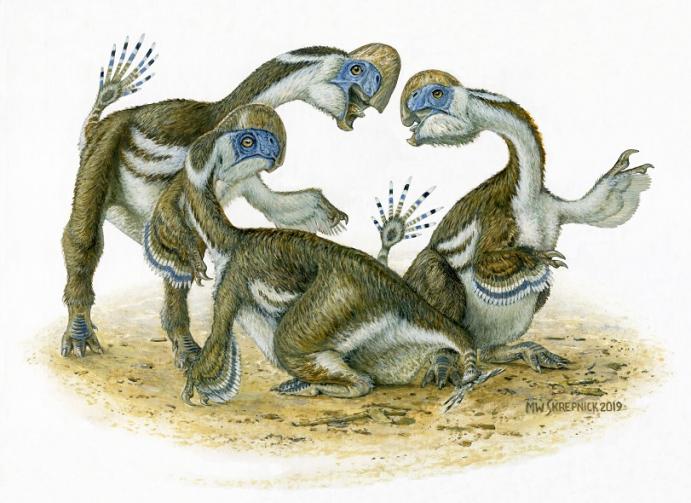Researchers have unveiled details of a new dinosaur species, Oksoko avarsan, which had a parrot-like beak and just two functional digits on its forearms – one fewer than its close relatives, suggesting an ability to diversify and adapt to new surroundings.
Based on six years of research, the experts behind this study say that the toothless, feather-covered dinosaur would have lived around 72-66 million years ago, growing to some two metres (6.6 feet) in length as an adult.
It’s what the species tells us about the evolution of the oviraptor family of dinos that’s most interesting though: a species losing a functional finger like this hasn’t been seen before, and it’s evidence of a changing diet and lifestyle.
Artist’s impression of Oksoko avarsan dinosaurs. (Michael Skrepnick)
“Oksoko avarsan is interesting because the skeletons are very complete and the way they were preserved resting together shows that juveniles roamed together in groups,” says palaeontologist Gregory Funston from the University of Edinburgh in the UK.
“But more importantly, its two-fingered hand prompted us to look at the way the hand and forelimb changed throughout the evolution of oviraptors – which hadn’t been studied before. This revealed some unexpected trends that are a key piece in the puzzle of why oviraptors were so diverse before the extinction that killed the dinosaurs.”
The research suggests that the hands and arms of these creatures changed drastically as they migrated to new parts of the world, including what is now North America and the Gobi Desert in Mongolia (which is where the bones were discovered).
This ability to adapt to different habitats and food supplies – shown through the switch from three to two functional fingers – helps to explain why this family of omnivorous dinosaurs was so diverse before the extinction event that wiped them out.
Through close analysis of other skeletons – including identifying marks on skulls and forelimbs– the team was able to identify O. avarsan as a new species. The discovery was confirmed by the tiny nub of a third finger bone where an entire finger should be.

This gradual finger loss would have happened over millions of years, and the researchers think it may have been an adaptation for desert living.
As multiple skeletons were recovered in resting poses, the species was likely one that hung out in social groups.
There’s still a lot to discover about Late Cretaceous oviraptors that lived in this part of the world – including the colour of their eggs and the nests they built – but the new study offers some intriguing insight about their evolution and diversification.
“Oviraptorids were a minor but exceptionally diverse part of the ecosystems they inhabited, and they appear to have been uniquely able to diversify and coexist in the latest Cretaceous ecosystems of Asia,” the researchers conclude in their paper.
The research has been published in Royal Society Open Science.



